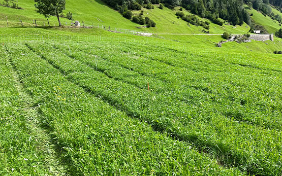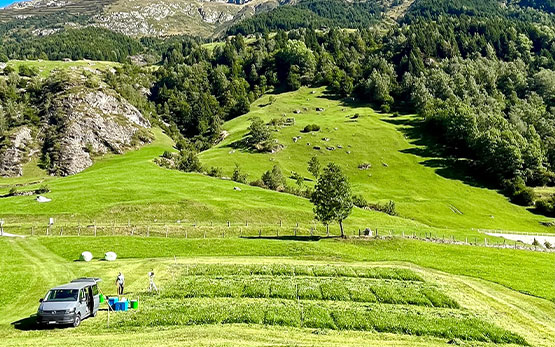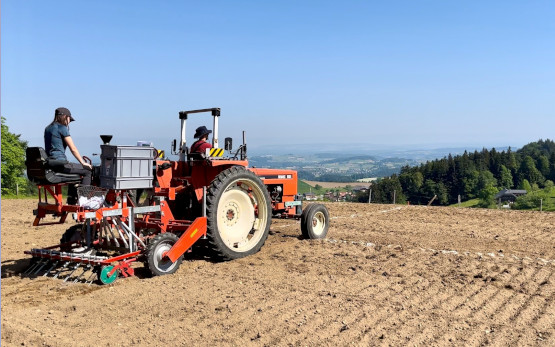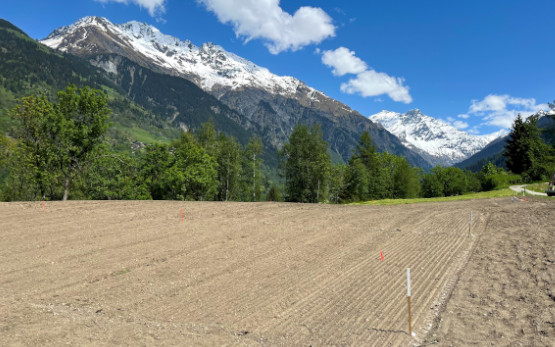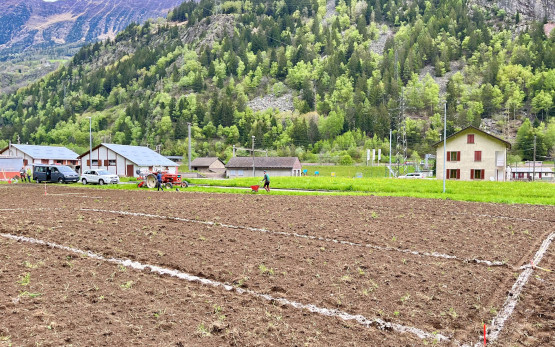The frequency and intensity of summer droughts are increasing as a result of climate change. In mountainous areas, where the growing season is already short, the yield and quality of grassland forage are increasingly diminishing during dry years. The #DryMountProject (2023-2027) aims to test new forage mixtures that are better adapted to drought. It is being conducted in the five partner cantons of the experimental station for Alpine and Mountain Farming.

Mixture composition
The DryMount project aims to create drought-resistant mixtures that produce good yields of high-quality forage when rainfall conditions are optimal for grass growth.
Nine new mixtures were created for the trial in order to determine the best compromise between productivity and drought resistance. Each mixture contains one dominant main species which is productive and others (0, 15 or 30%) considered to be drought-resistant. The dominant species are either cocksfoot grass or meadow foxtail, or a combination of the two, supplemented by other species commonly found in standard mixtures (e.g. Kentucky bluegrass, timothy, red clover). Other more drought-resistant species (red fescue, ribwort plantain, common bent and bird’s-foot trefoil) are then added to these basic mixtures. Two mixtures commonly sown in mountainous areas were used as controls. A total of eleven mixtures were sown on the five sites in May-June 2023, along a rainfall gradient (850 to 1600 mm).

Responses of mixtures to drought
In order to gain a better understanding of the resistance of these mixtures to water scarcity, a drought simulation is being set up at the experimental site in the canton of Berne during the summers of 2024 and 2025. The mixtures will be sown twice, with one half being exposed to ambient rainfall at the site, and the other half receiving only 70% of local rainfall during the summer months (June, July, August), according to climate forecasts for 2060.
The yield, botanical composition and forage quality of the mixtures, as well as the functional traits of the leaves and roots of the different species, will be evaluated over a four-year period (doctoral thesis of Emilie Roinel, 2023-2027).
Year of sowing (2023)
A first cut was taken at four of the five sites between August and September. In this year, which was marked by drought and intense summer heat waves, the results show that forage yields were 25% higher in mixtures comprising 15% drought-resistant species compared with mixtures that did not contain drought-resistant species – and as much as 44% higher in the those containing 30% drought-resistant species. These initial findings are very promising considering that they are from the first year after sowing.
First year forage harvest (2024)
All mixtures were harvested at the five experiment sites. In a year marked by relatively wet conditions, the results show that forage yield was similar for the mixtures with or without drought-resistant species, thus indicating that the presence of drought-resistant species does not reduce yield under optimal growing conditions.
At the Bern site, where we manipulated drought during the second growing cycle (7 weeks in summer), we found that drought reduced forage yield, but this reduction was lower in the presence of drought-resistant species (30% reduction compared to 50% reduction in the absence of drought-resistant species) suggesting that these species can reduce the negative impact of drought on mixture yield. However, we simultaneously showed that the drought-resistant species could have slight negative impacts on forage quality (up to 10% decrease in crude protein and 30% increase in lignin content), highlighting the need to find a compromise between forage yield and quality. The abundance of drought-resistant species was strongly influenced by ribwort plantain (Plantago lanceolata), showing that this species has a strong potential to limit yield loss under drought.
Contact
Further Information (in German)
Last modification 22.04.2025







